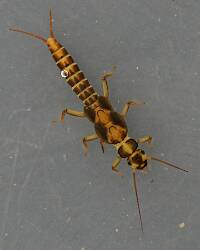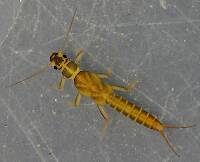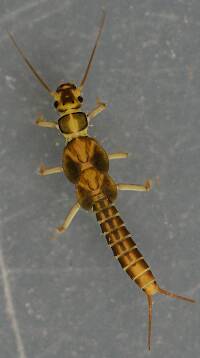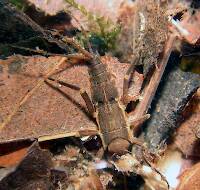
Hex Mayflies
Hexagenia limbata
The famous nocturnal Hex hatch of the Midwest (and a few other lucky locations) stirs to the surface mythically large brown trout that only touch streamers for the rest of the year.
Featured on the forum

With a bit of help from the microscope, this specimen keys clearly and unsurprisingly to Hydropsyche.

Troutnut is a project started in 2003 by salmonid ecologist Jason "Troutnut" Neuswanger to help anglers and
fly tyers unabashedly embrace the entomological side of the sport. Learn more about Troutnut or
support the project for an enhanced experience here.
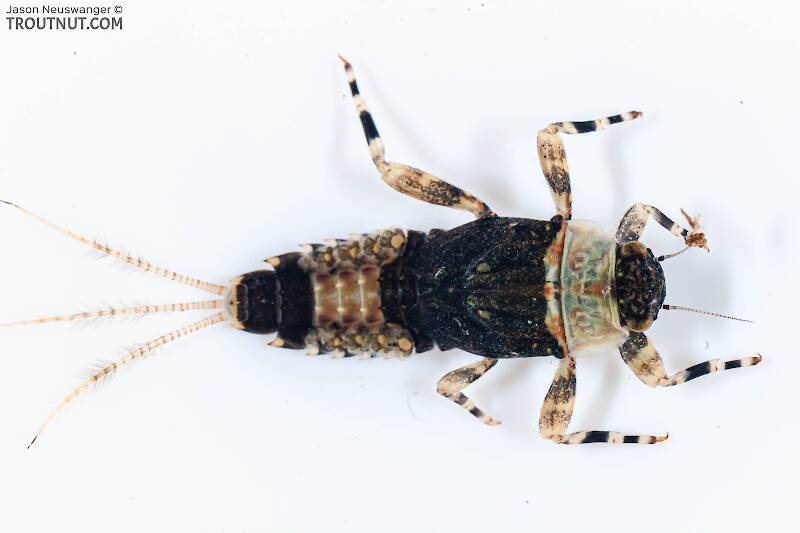
I've never seen this strange coloration on any Ephemerella subvaria nymph in a book before, but it's similar to several other specimens I collected on the same outing, including a smaller one that I photographed. They were outnumbered by the "normal" Ephemerella subvaria nymphs in the sample.
Troutnut on Oct 31, 2006October 31st, 2006, 5:05 pm EST
I found a few of these this spring in just one small Finger Lakes tributary, mixed in with various normal-looking E. subvaria nymphs. The unusual characteristic is the pale prothorax -- the "white collar" segment just behind the head. I've never heard of that color configuration before. Has anyone else?
Maybe they're mayfly clergy...
Maybe they're mayfly clergy...
Jason Neuswanger, Ph.D.
Troutnut and salmonid ecologist
Troutnut and salmonid ecologist
GONZO on Nov 1, 2006November 1st, 2006, 5:37 am EST
Very interesting specimen, Jason. I have no answer, but I do have an observation. Aside from the unusual translucent quality, I notice that the pronotum is also asymmetrical. The blunt forward left-hand corner would seem to indicate that the nymph sustained some sort of injury or other deformation, perhaps in an earlier instar. I hesitate to suggest this as an explanation because you indicated that you found others with the same coloration/deformity.
GONZO on Nov 1, 2006November 1st, 2006, 5:47 am EST
Jason,
Just took a look at the second smaller specimen. (Sorry, I'm a little slow on the uptake today.) I see no sign of injury or deformity on this one. I did notice, however, that both specimens appear to be female. (?)
Just took a look at the second smaller specimen. (Sorry, I'm a little slow on the uptake today.) I see no sign of injury or deformity on this one. I did notice, however, that both specimens appear to be female. (?)
Taxon on Nov 1, 2006November 1st, 2006, 2:28 pm EST
Jason-
The only thing I can come up with is that, perhaps it was freshly molted, and had not yet acquired pigmentation in that area for some reason. However, I would be willing to bet that Ethan Bright has seen that condition before, and would know its cause. I owe him a response on another subject, so will also alert him to the question.
The only thing I can come up with is that, perhaps it was freshly molted, and had not yet acquired pigmentation in that area for some reason. However, I would be willing to bet that Ethan Bright has seen that condition before, and would know its cause. I owe him a response on another subject, so will also alert him to the question.
Taxon on Nov 2, 2006November 2nd, 2006, 2:47 am EST
Jason-
You know, now that I look at it more closely, particularly after lightening the photo, it appears to have mature wingpads. So, I suspect it may just be in an early stage of molt to subimago. The translucency probably results from initial separation on the pro-thoracic plate and the leading edge of the meso-thoracic plate. In any event, I'm hoping to hear for sure from Ethan Bright.
You know, now that I look at it more closely, particularly after lightening the photo, it appears to have mature wingpads. So, I suspect it may just be in an early stage of molt to subimago. The translucency probably results from initial separation on the pro-thoracic plate and the leading edge of the meso-thoracic plate. In any event, I'm hoping to hear for sure from Ethan Bright.
Troutnut on Nov 2, 2006November 2nd, 2006, 3:15 am EST
Interesting ideas.
I don't think it could be molting to a subimago, because March 29th is a little early for me to be catching any like that, let alone several. I photographed 2 but I actually captured probably 4 or 5 with that color pattern. I should have mentioned that earlier.
I'm fairly convinced it's a pigmentation thing. They didn't really seem "translucent" to me, just olive-colored. Of course there's a bit of inherent translucency, but it didn't seem like more than in any other olive-bodied nymph.
It's interesting that the leading edge of the mesothorax has that color in these, too.
I don't think it could be molting to a subimago, because March 29th is a little early for me to be catching any like that, let alone several. I photographed 2 but I actually captured probably 4 or 5 with that color pattern. I should have mentioned that earlier.
I'm fairly convinced it's a pigmentation thing. They didn't really seem "translucent" to me, just olive-colored. Of course there's a bit of inherent translucency, but it didn't seem like more than in any other olive-bodied nymph.
It's interesting that the leading edge of the mesothorax has that color in these, too.
Jason Neuswanger, Ph.D.
Troutnut and salmonid ecologist
Troutnut and salmonid ecologist
Taxon on Nov 2, 2006November 2nd, 2006, 5:40 pm EST
Jason-
This is the response I received from Ethan Bright this morning:
This is the response I received from Ethan Bright this morning:
Boy, he takes great photos. My thinking mirrors yours - cuticular ecdysis hasn’t completed, or the old cuticle will not come off. Based on the relative evenness of the tone, I think it rules out a fungal infection.
Cheers, Ethan
Konchu on Nov 21, 2006November 21st, 2006, 10:46 am EST
I have collected many ephemerellids that show this, and more, color variation. I really don't think it is much more complicated than that. The more you look, the more you'll see.
Oldredbarn on Aug 17, 2009August 17th, 2009, 9:33 am EDT
Jason,
I am going to go out on a limb here. I would like to know the date that you photographed these nymphs. My guess is that this one is about to pop. I think that the lighter color around the "shoulders" is where the subimago has separated itself from the nymphal shuck on the inside.
As we all know emergence is not an easy task. The bug has to work at it. I have read about the nymph making many false trips towards the serface film. The reason may be because it's not quite ready.
Years ago I was fishing on the North Branch of the Au Sable in Michigan with my 12 year old nephew. We sat down on a rather large log to take a break and eat something. A dragonfly nymph crawled out on the log between us. My nephew was new to the game and asked me what it was.
As we sat there eating our snack the bug began to shake rather violently. It was strange. You could almost see the adult form through the old skin. Eventually the wingpad split open and out came a full grown dragonfly. It came out like those pictures in slow motion of a bean plant popping up out of the soil. This whole process took some time.
The violent shaking, I think, is the bug trying to dislodge itself from the inside away from it's old skin. It has to start this, I would imagine, early on in the emergence cycle and would have to do it many times to be successful. I think that the "stillborns" we see, and I think there are more than we believe, are unable to pull themselves free from the inside of the shuck.
One final story. Maybe some clues as to how to use this info when fishing. I float with a guide once a year on the Au Sable. He and I have been friends for two decades at least. Awhile back we had two years in a row where we ended our evening under swarms of Brown Drakes.
We stopped for lunch and tied up to an old dock. Under the dock were a dozen or so Brown Drakes stuck in their shucks. They were still alive but nearly spent from trying to hatch. We picked up a handful and tossed them out in to the current. As they floated downstream all of them were inhaled by trout.
Later that night I was casting to a few nice feeding fish and my friend decided to give me his "Three D's of Drake Fishing"...The three D's stand for "Do Drag Drakes!" He was giving me a bit of a hard time about my perfect "drag-free-floats". He told me that I was doing too good of a job on my presentaion. "When your fly is over where you think the fish is, twitch it a bit."
He said that this is a large, living insect and it's emergence isn't so dainty. I started to give the fly a tiny bit of action and bam! They smacked it like it was the last bug of the night.
The messiness involved with the hatching process probably accounts for the success of some beginners. How many times have you had you fly hit at the tail end of a float?
Anyway! Just some idle thoughts. By the way...I love your site! These are wonderful photos. There are so many of them I wonder if you ever get a chance to wet a line!!!
Spence
I am going to go out on a limb here. I would like to know the date that you photographed these nymphs. My guess is that this one is about to pop. I think that the lighter color around the "shoulders" is where the subimago has separated itself from the nymphal shuck on the inside.
As we all know emergence is not an easy task. The bug has to work at it. I have read about the nymph making many false trips towards the serface film. The reason may be because it's not quite ready.
Years ago I was fishing on the North Branch of the Au Sable in Michigan with my 12 year old nephew. We sat down on a rather large log to take a break and eat something. A dragonfly nymph crawled out on the log between us. My nephew was new to the game and asked me what it was.
As we sat there eating our snack the bug began to shake rather violently. It was strange. You could almost see the adult form through the old skin. Eventually the wingpad split open and out came a full grown dragonfly. It came out like those pictures in slow motion of a bean plant popping up out of the soil. This whole process took some time.
The violent shaking, I think, is the bug trying to dislodge itself from the inside away from it's old skin. It has to start this, I would imagine, early on in the emergence cycle and would have to do it many times to be successful. I think that the "stillborns" we see, and I think there are more than we believe, are unable to pull themselves free from the inside of the shuck.
One final story. Maybe some clues as to how to use this info when fishing. I float with a guide once a year on the Au Sable. He and I have been friends for two decades at least. Awhile back we had two years in a row where we ended our evening under swarms of Brown Drakes.
We stopped for lunch and tied up to an old dock. Under the dock were a dozen or so Brown Drakes stuck in their shucks. They were still alive but nearly spent from trying to hatch. We picked up a handful and tossed them out in to the current. As they floated downstream all of them were inhaled by trout.
Later that night I was casting to a few nice feeding fish and my friend decided to give me his "Three D's of Drake Fishing"...The three D's stand for "Do Drag Drakes!" He was giving me a bit of a hard time about my perfect "drag-free-floats". He told me that I was doing too good of a job on my presentaion. "When your fly is over where you think the fish is, twitch it a bit."
He said that this is a large, living insect and it's emergence isn't so dainty. I started to give the fly a tiny bit of action and bam! They smacked it like it was the last bug of the night.
The messiness involved with the hatching process probably accounts for the success of some beginners. How many times have you had you fly hit at the tail end of a float?
Anyway! Just some idle thoughts. By the way...I love your site! These are wonderful photos. There are so many of them I wonder if you ever get a chance to wet a line!!!
Spence
"Even when my best efforts fail it's a satisfying challenge, and that, after all, is the essence of fly fishing." -Chauncy Lively
"Envy not the man who lives beside the river, but the man the river flows through." Joseph T Heywood
"Envy not the man who lives beside the river, but the man the river flows through." Joseph T Heywood
GONZO on Aug 17, 2009August 17th, 2009, 10:04 am EDT
Nice observations, Spence. Jason mentions in one of his posts above that the nymph was photographed on March 29th. As he says, that does seem early (though possible) for the nymph to be in the process of emerging into a dun. However, it could also be in the process of shedding from one nymphal instar to another. I usually see evidence of the old "skin" loosening around the head and eyes first, and it does seem strange that he would find several with the same pale pronotum. Perhaps, as Konchu suggests, it is just a color variation or anomaly.
Oldredbarn on Aug 17, 2009August 17th, 2009, 10:33 am EDT
Gonzo,
I didn't see their posts my first time around. I had googled E subvaria for some reason today and the first link was to photos of those nymphs.
I think it's easier sometimes to observe these processes on the larger bugs. Maybe it's because my eyes aren't what they use to be. I have seen these Brown Drakes struggling to free themselves usually in the backwaters of the river. It really looks like a job!
I think of them hatching with only so much fuel (energy) in the tank, so-to-speak. They don't re-fuel. So, if there are any bumps in the road that calls for more energy to be expended, they could basically run out of gas. If you have ever watched them in this state...dying takes some time...it's a slow process. I can't really tell if they are drowning or have no strength left or both.
It's no wonder really that trout would rather chase something that seems to be unable to get away. Less energy being used on their part as well, eh!
Anyway...I think you are probably correct and these bugs may be in between costume changes.
How did you get a nickname like "Gonzo"? Are you a Hunter S Thompson fan?
Take Care!
Spence
I didn't see their posts my first time around. I had googled E subvaria for some reason today and the first link was to photos of those nymphs.
I think it's easier sometimes to observe these processes on the larger bugs. Maybe it's because my eyes aren't what they use to be. I have seen these Brown Drakes struggling to free themselves usually in the backwaters of the river. It really looks like a job!
I think of them hatching with only so much fuel (energy) in the tank, so-to-speak. They don't re-fuel. So, if there are any bumps in the road that calls for more energy to be expended, they could basically run out of gas. If you have ever watched them in this state...dying takes some time...it's a slow process. I can't really tell if they are drowning or have no strength left or both.
It's no wonder really that trout would rather chase something that seems to be unable to get away. Less energy being used on their part as well, eh!
Anyway...I think you are probably correct and these bugs may be in between costume changes.
How did you get a nickname like "Gonzo"? Are you a Hunter S Thompson fan?
Take Care!
Spence
"Even when my best efforts fail it's a satisfying challenge, and that, after all, is the essence of fly fishing." -Chauncy Lively
"Envy not the man who lives beside the river, but the man the river flows through." Joseph T Heywood
"Envy not the man who lives beside the river, but the man the river flows through." Joseph T Heywood
GONZO on Aug 17, 2009August 17th, 2009, 11:36 am EDT
How did you get a nickname like "Gonzo"? Are you a Hunter S Thompson fan?
Sort of, but the two aren't really related. It's just a very old ski school nickname that stuck--a shortening of my last name.
Hellgie
Posts: 5
Posts: 5
Hellgie on Mar 12, 2010March 12th, 2010, 8:18 am EST
This looks more like a Drunella (Blue-winged olive) nymph. They look similar to the earlier Ephemerellas except Drunella sport a light thoracic collar on some species. Could it be you probably collected the specimens on the cusp when the Drunellas were starting to become active?
Troutnut on Mar 12, 2010March 12th, 2010, 4:35 pm EST
Interesting ideas, but it's not Drunella, and it's not molting. It's really a Hendrickson nymph that looks like this.
Jason Neuswanger, Ph.D.
Troutnut and salmonid ecologist
Troutnut and salmonid ecologist
Backcast on Mar 19, 2010March 19th, 2010, 3:06 am EDT
I found a bunch of Hendrickson nymphs while flipping rocks yesterday(March 18th) in northwest PA.Everyone of them bore this same coloration.Given that these nymphs display this feature at roughly the same time period and near the same latitude as Jason's specimen,my unscientific guess is that it is of some pre-emergence significance,as they all had dark wingpads too.
Quick Reply
Related Discussions
Topic
Replies
Last Reply
1
May 11, 2007
by Troutnut
by Troutnut
6
Sep 22, 2006
by Troutnabout
by Troutnabout






